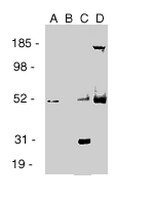GR39 Sigma-AldrichAnti-Estrogen Receptor β (Ab-2) Mouse mAb (9.88)
Recommended Products
Overview
| Replacement Information |
|---|
Key Specifications Table
| Species Reactivity | Host | Antibody Type |
|---|---|---|
| H, M, R | M | Monoclonal Antibody |
| Product Information | |
|---|---|
| Form | Liquid |
| Formulation | Undiluted ascites. |
| Positive control | Recombinant human estrogen receptor β protein, PC12 cells, or mouse brain |
| Preservative | ≤0.1% sodium azide |
| Quality Level | MQ100 |
| Biological Information | |
|---|---|
| Immunogen | recombinant, human estrogen receptor β |
| Immunogen | Human |
| Clone | 9.88 |
| Host | Mouse |
| Isotype | IgM |
| Species Reactivity |
|
| Antibody Type | Monoclonal Antibody |
| Physicochemical Information |
|---|
| Dimensions |
|---|
| Materials Information |
|---|
| Toxicological Information |
|---|
| Safety Information according to GHS |
|---|
| Safety Information |
|---|
| Product Usage Statements |
|---|
| Packaging Information |
|---|
| Transport Information |
|---|
| Supplemental Information |
|---|
| Specifications |
|---|
| Global Trade Item Number | |
|---|---|
| Catalog Number | GTIN |
| GR39 | 0 |
Documentation
Anti-Estrogen Receptor β (Ab-2) Mouse mAb (9.88) SDS
| Title |
|---|
Anti-Estrogen Receptor β (Ab-2) Mouse mAb (9.88) Certificates of Analysis
| Title | Lot Number |
|---|---|
| GR39 |
References
| Reference overview |
|---|
| Shughrue, P.J., et al. 1998. Endocrinol. 139, 5267. Al-Shamma, H.A. and Arnold, A.P. 1997. Proc. Natl. Acad. Sci. USA 94, 1521. Li, X., et al. 1997. Neuroendocrinol. 66, 63. Pettersson, K., et al. 1997. Mol. Endocrinol. 11, 1486. Pratt, W.B. and Toft, D.O. 1997. Endocrine Rev. 18, 306. Shughrue, P.J., et al. 1997. J. Comp. Neurol. 388, 507. Schumacher, M., et al. 1996. Dev. Neurosci. 18, 6. Toran-Allerand, C.D. 1996. Dev. Neurosci. 18, 36. Weigel, N.L. 1996. Biochem J. 319, 657. Jones, K.J. 1994. Ann. N.Y. Acad. Sci. 743, 141. Arnold, A.P. 1990. in Hormones, Brain and Behavior in Vertebrates, ed. Balthazart, J. (Karger, Basel), 82. |








